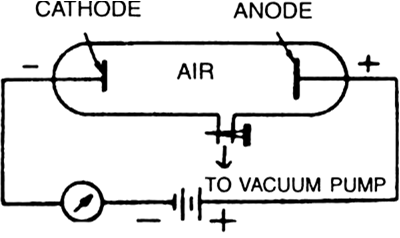What are the cathode rays? How are they produced?
When the pressure in the discharge tube (Fig) falls below 0.001 mm Hg and a potential difference of about 10,000 volts is applied across the electrodes, the walls of the discharge tube opposite to the cathode starts glowing with a faint greenish light. This is due to the bombardment of walls by some rays emerging from the cathode or negative electrode. These rays are known as cathode rays. These observations lead to the conclusion that cathode rays consist of rapidly moving negatively charged particles. These are called electrons and are shot out from the cathode of a discharge tube when an electric current is passed at high voltage through a gas at very low pressure.



